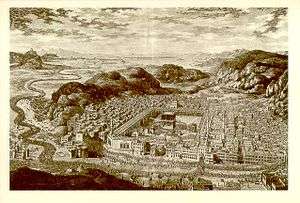Abu Tahir al-Jannabi
| Abū Tāhir | |||||
|---|---|---|---|---|---|
| Ruler of the Qarmatian State | |||||
 | |||||
| Reign | 923–944 | ||||
| Coronation | 923 | ||||
| Predecessor | Abū Saʿīd al-Jannābī | ||||
| Successor | Succeeded by his 3 surviving sons and nephews | ||||
| Born |
c. 906 Bahrain | ||||
| Died |
944 Bahrain | ||||
| Burial | ???? | ||||
| |||||
| Dynasty | Qarmatian state | ||||
Abū Tāhir Sulaymān al-Jannābī (906–944) (Arabic: ابوطاهر سلیمان الجنّابي) was the ruler of the Qarmatian state in Bahrain (historical region) and Eastern Arabia, who in 930 led the sacking of Mecca.
The brother of Abū Saʿīd Hasan ibn Bahrām al-Jannābī, the founder of the Qarmatian state, Abū Tāhir became leader of the state in 923.[1] He immediately began an expansionist phase, raiding Basra that year. He raided Kufa in 927, defeating an Abbasid army in the process, and threatened Baghdad in 928 before pillaging much of Iraq when he could not gain entry to the city.[2]
In 930, he led the Qarmatians' most notorious attack when he pillaged Mecca and desecrated Islam's most sacred sites. Unable to gain entry to the city initially, Abū Tāhir called upon the right of all Muslims to enter the city and gave his oath that he came in peace. Once inside the city walls the Qarmatian army set about massacring the pilgrims, taunting them with verses of the Koran as they did so[3] The bodies of the pilgrims were left to rot in the streets or thrown down the Well of Zamzam. The Kaaba was looted, with Abū Tāhir taking personal possession of the Black Stone and bringing it back to Al-Hasa.
Early life
Tāhir Sulaymān's brother Abū Saʿīd was a tribal chief of Banu Janab a branch of Banu Kalb tribe, he had initiated the militarization of the Qarmatians.[4] Abū Saʿīd began preaching against Sunni Islam around 890[5] after being taught by his mentor Hamdan Qarmat, a native of Syria, from whose name the Qarmatian sect is derived.[5] Tāhir was influenced heavily by his brother and learned to fight early on, along with his followers.[4] Abū Tāhir and Abū Saʿīd started off plundering caravans, traders and Persian pilgrims en route to Mecca before gathering a large following.[4] The brothers soon mobilized an army and set out to lay siege to Basra. However, the governor of Basra learned of their preparations and informed the Abbasid Caliph, al-Muktafi, in Baghdad. The Caliph sent the Persian General Abbas bin Umar to save Basra,[4] but Abbas was defeated and his men executed and the Qarmatian siege was successful in capturing the city.[4]
Rise to power
Abū Saʿīd's success in capturing most of Eastern Arabia encouraged him to lay siege to Hajr, a strategic city near the Persian Gulf, after doing so he appointed his son Sayeed the crown prince.[4] This move that angered Abū Tāhir, and he soon assassinated his older brother and declared himself chief of the Qarmatians in 923.[4]
Early reign
Soon after succeeding al-Muktafi, Caliph al-Muqtadir recaptured Basra and ordered the re-fortification of the city. Abū Tāhir successfully laid siege to the city once more, defeating the Abbasid army. After capturing Basra the Qarmatians proceeded to loot it and then withdrew.[4] Abū Tāhir returned again and ravaged it totally, destroying the grand mosque and reducing the marketplace to ashes.[4] He ruled Bahrain successfully during this time and corresponded with local and foreign rulers as far as north Africa, but continued successfully fighting off assaults from the Persians, who were allied with the Caliph in Baghdad.[4]
Conquests
Abū Tāhir began to frequently raid Muslim pilgrims, reaching as far as the Hijaz region. On one of his raids he succeeded in capturing Abu'l-Haija bin Hamdun, who was an Abbasid commander. In 926 he led his army deep into Abbasid Iraq, reaching as far north as Kufa, forcing the Abbasids to pay large sums of money in for him to leave the city in peace. On his way home he ravaged the outskirts of Kufa anyway.[4] On his return, Abū Tāhir began building palaces in the city of Ahsa, not only for himself but for his fellows, and declared the city his permanent capital.[4] In 928 Caliph al-Muqtadir felt confident enough to once again confront Abū Tāhir, calling in his generals Yusaf bin Abi As'saj from Azerbaijan, Munis Khadim, Muzaffar and Harun[4] After a heavy battle all were beaten and driven back to Baghdad.[4] Abū Tāhir destroyed Jazirah Province as a final warning to the Abbasids and returned to Ahsa.[4]
Abū Tāhir thought that he had identified the Mahdi as a young Persian prisoner from Isfahan by the name of Abu'l-Fadl al-Isfahani, who claimed to be the descendant of the Persian kings.[6][7][8][9][9][10] Al-Isfahani had been brought back to Bahrain from the Qarmatians' raid into Iraq in 928.[11] In 931, Abū Tāhir turned over the state to this Mahdi-Caliph, who instituted the worship of fire and the burning of religious books during an eighty-day rule. His reign culminated in the execution of members of Bahrain's notable families, including members of Abū Tāhir's family.[12] Fearing for his own life, Abū Tāhir announced that he had been wrong and denounced the al-Isfahani as a false Madhi. Begging forgiveness from the other notables, Abū Tāhir had him executed.[13]
Invasion of Mecca

In 930, Abū Tāhir led the Qarmatians' most famous attack when he pillaged Mecca and desecrated Islam's most sacred sites. Unable to gain entry to the city initially, he called upon the right of all Muslims to enter the city and gave his oath that he came in peace. Once inside the city walls the Qarmatian army set about massacring the pilgrims, taunting them with verses of the Koran as they did so.[3] The bodies of the pilgrims were left to rot in the streets or thrown down the Well of Zamzam. The Kaaba was looted, with Abū Tāhir taking personal possession of the Black Stone and bringing it back to Al-Hasa.
The attack on Mecca symbolized the Qarmatians' break with Sunni world; it was believed to have been aimed to prompt the appearance of the Mahdi who would bring about the final cycle of the world and end the era of Islam.[13]
On the first day of the Hajj they led a charge on pilgrims, riding their horses into Masjid al-Haram and killing pilgrims praying around the Kaaba. Their victims allegedly numbered around some thirty thousand. After despoiling the Well of Zamzam, plundering houses and seizing slaves, Abū Tāhir and his army removed the Black Stone and took it away.[5]
Final years and death
Abū Tāhir resumed the reins of the Qarmatian state and again began attacks on pilgrims crossing Arabia. Attempts by the Abbasids and Fatimids to persuade him to return the Black Stone were rejected.
He died in 944 after suffering from smallpox and was succeeded by his three surviving sons and nephews.[14]
See also
References
- ↑ Daftary 1990, p. 160.
- ↑ Halm 1996, p. 255.
- 1 2 Halm 1996, pp. 255 f..
- 1 2 3 4 5 6 7 8 9 10 11 12 13 14 15 Najībābādī, Akbar Shāh K̲h̲ān (2001). Salafi, Muhammad Tahir, ed. The History of Islam. Volume 2. Darussalam. ISBN 978-9960-892-93-1.
- 1 2 3 Wynbrandt, James (2004). A Brief History of Saudi Arabia. Infobase Publishing. ISBN 978-1-4381-0830-8.
- ↑ Imagining the End: Visions of Apocalypse By Abbas Amanat, Magnus Thorkell - Page 123
- ↑ Women and the Fatimids in the World of Islam - Page 26 by Delia Cortese, Simonetta Calderini
- ↑ Early Philosophical Shiism: The Ismaili Neoplatonism of Abū Yaʻqūb Al-Sijistānī - Page 161 by Paul Ernest Walke
- 1 2 The Other God: Dualist Religions from Antiquity to the Cathar Heresy by Yuri Stoyanov
- ↑ Classical Islam: A History, 600–1258 - Page 113 by Gustave Edmund Von Grunebaum
- ↑ Halm 1996, p. 257.
- ↑ Farhad Daftary, The Assassin Legends: Myths of the Isma'ilis, IB Tauris, 1994, p21
- 1 2 Daftary 1990, p. 162.
- ↑ Halm 1996, p. 383.
Bibliography
- Daftary, Farhad (1990). The Isma'ilis: Their History and Doctrines. Cambridge University Press. ISBN 0-521-37019-1.
- Halm, Heinz (1996). The Empire of the Mahdi: The Rise of the Fatimids. Brill. ISBN 978-90-04-10056-5.
